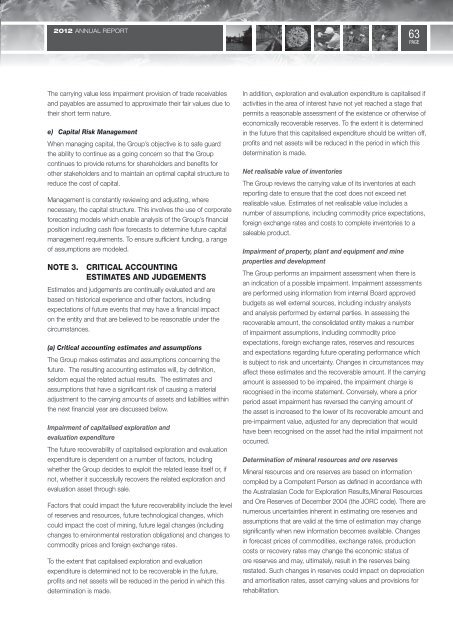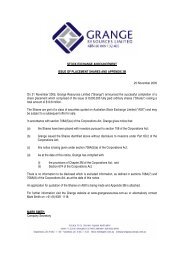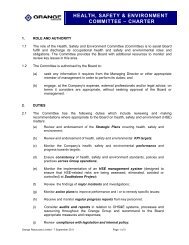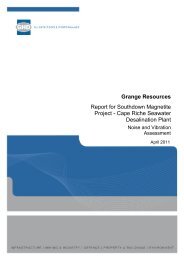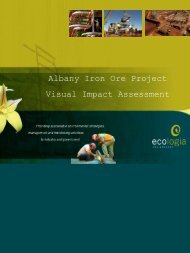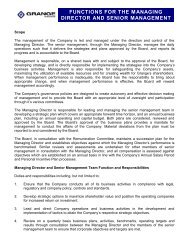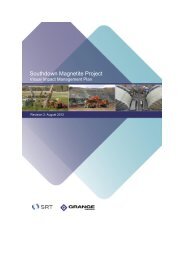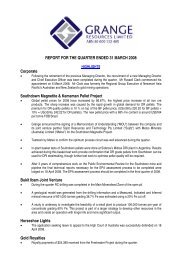2012 Annual Report (2 April 2013) - Grange Resources
2012 Annual Report (2 April 2013) - Grange Resources
2012 Annual Report (2 April 2013) - Grange Resources
You also want an ePaper? Increase the reach of your titles
YUMPU automatically turns print PDFs into web optimized ePapers that Google loves.
<strong>2012</strong> ANNUAL REPORT<br />
63<br />
PAGE<br />
The carrying value less impairment provision of trade receivables<br />
and payables are assumed to approximate their fair values due to<br />
their short term nature.<br />
e) Capital Risk Management<br />
When managing capital, the Group’s objective is to safe guard<br />
the ability to continue as a going concern so that the Group<br />
continues to provide returns for shareholders and benefits for<br />
other stakeholders and to maintain an optimal capital structure to<br />
reduce the cost of capital.<br />
Management is constantly reviewing and adjusting, where<br />
necessary, the capital structure. This involves the use of corporate<br />
forecasting models which enable analysis of the Group’s financial<br />
position including cash flow forecasts to determine future capital<br />
management requirements. To ensure sufficient funding, a range<br />
of assumptions are modeled.<br />
NOTE 3. CRITICAL ACCOUNTING<br />
ESTIMATES AND JUDGEMENTS<br />
Estimates and judgements are continually evaluated and are<br />
based on historical experience and other factors, including<br />
expectations of future events that may have a financial impact<br />
on the entity and that are believed to be reasonable under the<br />
circumstances.<br />
(a) Critical accounting estimates and assumptions<br />
The Group makes estimates and assumptions concerning the<br />
future. The resulting accounting estimates will, by definition,<br />
seldom equal the related actual results. The estimates and<br />
assumptions that have a significant risk of causing a material<br />
adjustment to the carrying amounts of assets and liabilities within<br />
the next financial year are discussed below.<br />
Impairment of capitalised exploration and<br />
evaluation expenditure<br />
The future recoverability of capitalised exploration and evaluation<br />
expenditure is dependent on a number of factors, including<br />
whether the Group decides to exploit the related lease itself or, if<br />
not, whether it successfully recovers the related exploration and<br />
evaluation asset through sale.<br />
Factors that could impact the future recoverability include the level<br />
of reserves and resources, future technological changes, which<br />
could impact the cost of mining, future legal changes (including<br />
changes to environmental restoration obligations) and changes to<br />
commodity prices and foreign exchange rates.<br />
To the extent that capitalised exploration and evaluation<br />
expenditure is determined not to be recoverable in the future,<br />
profits and net assets will be reduced in the period in which this<br />
determination is made.<br />
In addition, exploration and evaluation expenditure is capitalised if<br />
activities in the area of interest have not yet reached a stage that<br />
permits a reasonable assessment of the existence or otherwise of<br />
economically recoverable reserves. To the extent it is determined<br />
in the future that this capitalised expenditure should be written off,<br />
profits and net assets will be reduced in the period in which this<br />
determination is made.<br />
Net realisable value of inventories<br />
The Group reviews the carrying value of its inventories at each<br />
reporting date to ensure that the cost does not exceed net<br />
realisable value. Estimates of net realisable value includes a<br />
number of assumptions, including commodity price expectations,<br />
foreign exchange rates and costs to complete inventories to a<br />
saleable product.<br />
Impairment of property, plant and equipment and mine<br />
properties and development<br />
The Group performs an impairment assessment when there is<br />
an indication of a possible impairment. Impairment assessments<br />
are performed using information from internal Board approved<br />
budgets as well external sources, including industry analysts<br />
and analysis performed by external parties. In assessing the<br />
recoverable amount, the consolidated entity makes a number<br />
of impairment assumptions, including commodity price<br />
expectations, foreign exchange rates, reserves and resources<br />
and expectations regarding future operating performance which<br />
is subject to risk and uncertainty. Changes in circumstances may<br />
affect these estimates and the recoverable amount. If the carrying<br />
amount is assessed to be impaired, the impairment charge is<br />
recognised in the income statement. Conversely, where a prior<br />
period asset impairment has reversed the carrying amount of<br />
the asset is increased to the lower of its recoverable amount and<br />
pre-impairment value, adjusted for any depreciation that would<br />
have been recognised on the asset had the initial impairment not<br />
occurred.<br />
Determination of mineral resources and ore reserves<br />
Mineral resources and ore reserves are based on information<br />
compiled by a Competent Person as defined in accordance with<br />
the Australasian Code for Exploration Results,Mineral <strong>Resources</strong><br />
and Ore Reserves of December 2004 (the JORC code). There are<br />
numerous uncertainties inherent in estimating ore reserves and<br />
assumptions that are valid at the time of estimation may change<br />
significantly when new information becomes available. Changes<br />
in forecast prices of commodities, exchange rates, production<br />
costs or recovery rates may change the economic status of<br />
ore reserves and may, ultimately, result in the reserves being<br />
restated. Such changes in reserves could impact on depreciation<br />
and amortisation rates, asset carrying values and provisions for<br />
rehabilitation.


